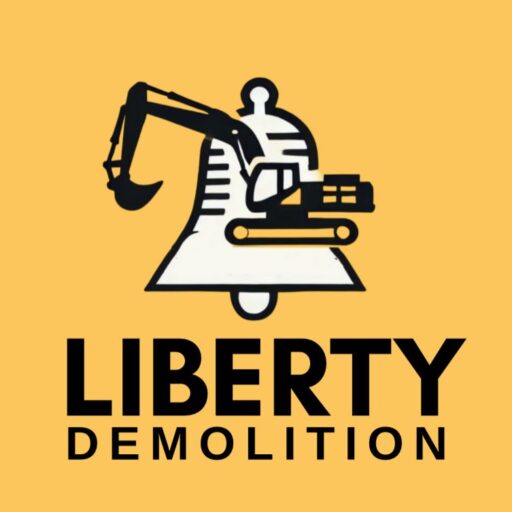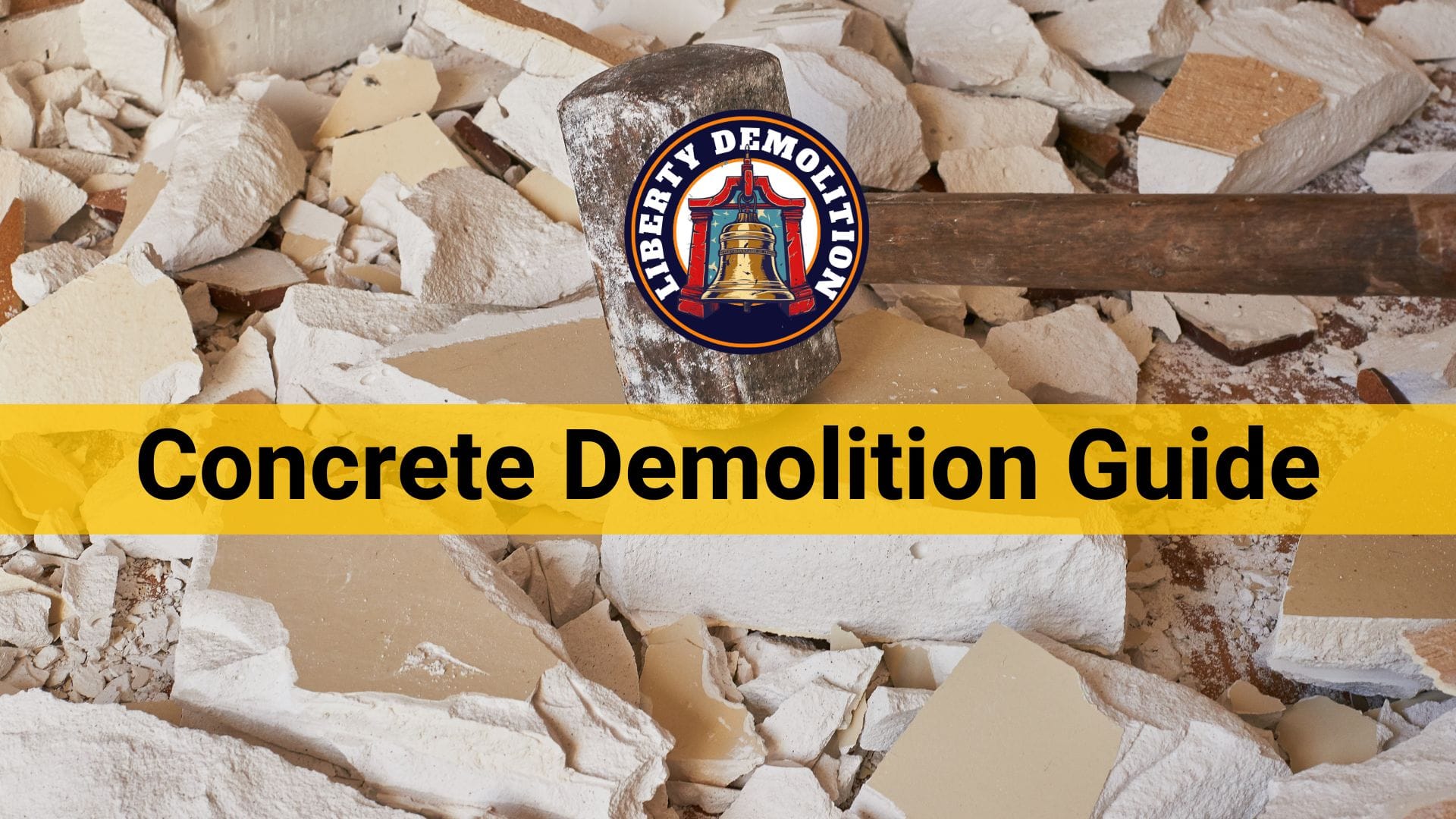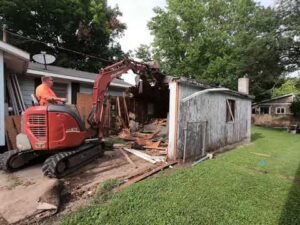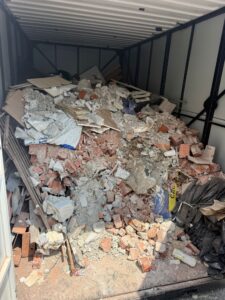Concrete demolition involves breaking down concrete structures or surfaces using different methods and equipment. The process ensures the safe and efficient removal of concrete, often preparing sites for redevelopment or reconstruction.
Intrigued about the ins and outs of concrete demolition? Keep reading!
What Is the Method of Concrete Demolition?
When we talk about concrete demolition, it refers to the process of tearing down concrete buildings, structures, or surfaces. But it’s not just about smashing things up. This procedure involves specific tools, techniques, and safety measures to make sure everything is done correctly and safely.
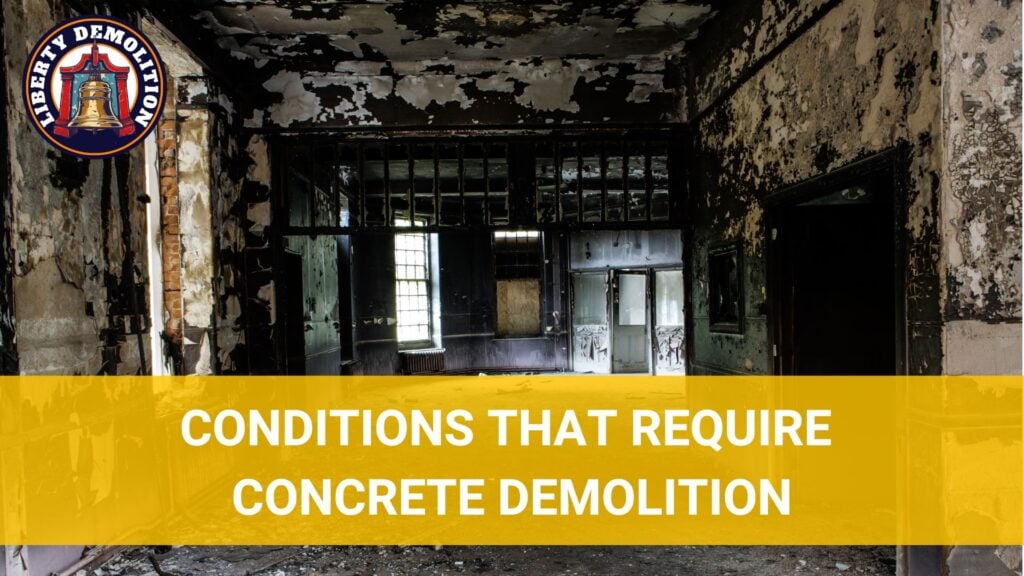
Conditions that Require Concrete Demolition and Replacement
There will come a time when concrete, no matter how durable, starts to show signs of wear and tear or simply becomes outdated in terms of design and purpose. But when do we know it’s time to get rid of the old and bring in the new?
Aging structures and infrastructure
- Wear and Tear: Continuous exposure to the elements – be it sun, rain, or snow – will, over time, cause concrete to crack, chip, or crumble. Once this happens, not only does it become an eyesore, but it can also be a hazard.
- Structural Weakness: As concrete gets older, it can become less sturdy.
- Efflorescence: Ever noticed those white, powdery deposits on old concrete surfaces? That’s efflorescence. It occurs when water-soluble salts present in the concrete get drawn out to the surface, hinting at deeper water infiltration issues.
Making Way for New Construction
- Modernization: Demolishing outdated concrete structures can pave the way for new, more relevant constructions.
- Space Utilization: In crowded urban areas, every inch of space counts. Getting rid of old, underutilized concrete structures can free up space for something more valuable.
- Infrastructure Upgrades: Roads, bridges, and tunnels often need widening or upgrading to accommodate the growing traffic and transportation demands. Demolishing specific portions of these structures can help achieve this.
Correcting Flawed or Unsafe Concrete Work
- Subpar Materials: If inferior quality materials were used in the original construction, the concrete could show signs of premature wear and damage.
- Poor Workmanship: If the professionals who laid the concrete didn’t do their job correctly, issues like uneven surfaces, bubbles, or weak joints might arise.
- Design Flaws: If a structure wasn’t designed well, it might not serve its intended purpose or might even be unsafe.
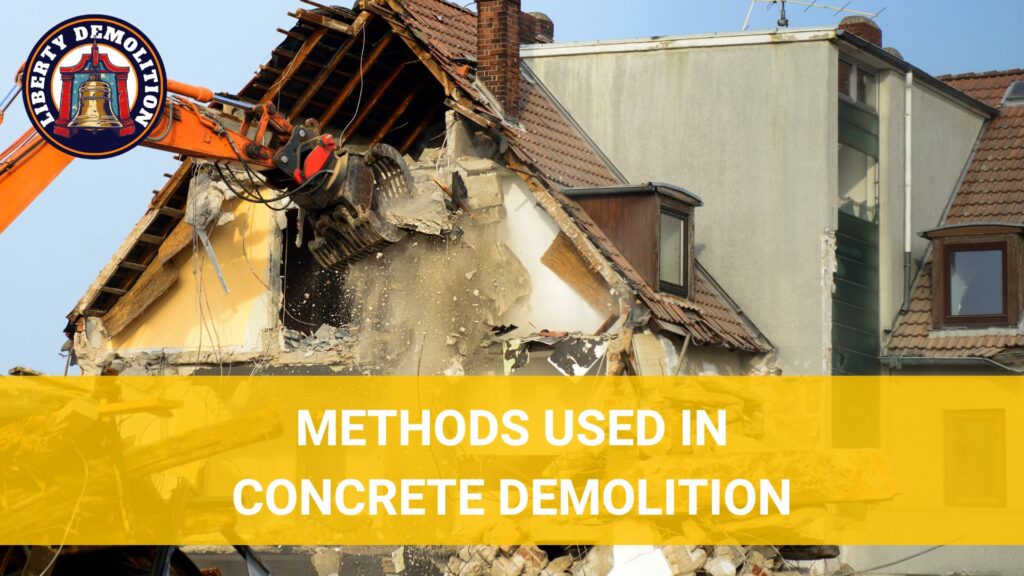
Methods Used in Concrete Demolition
Concrete demolition is a process that demands precision, safety, and the right set of tools. While the goal remains consistent—to break down and remove concrete—there are various methods and equipment available to achieve this.
This table offers a quick overview of the various methods and equipment used in concrete demolition, summarizing their operation, benefits, and challenges.
| Method/Equipment | How It Works | Advantages | Drawbacks |
| Mechanical | |||
| Jackhammers | Uses a hammer & chisel powered by air or electricity to chip away at concrete. | – Precision targeting. – Portable. | – Labor-intensive for large areas. – Can be taxing for operators. |
| Bulldozers | Massive machines pushing large chunks of concrete debris. | – Efficient for large-scale jobs. – Quick clearance & leveling. | – Lacks precision. – Requires skilled operators. |
| Chemical | |||
| Expansive Grouts | Chemical compounds expanding when hardening, causing concrete to crack. | – Quiet & no vibrations. – Cost-effective in certain scenarios. | – Time-consuming. – Unpredictable cracking extent. |
| Thermal | |||
| Heat Methods | Uses high-intensity torches to heat concrete, causing it to crack. | – Effective for removing reinforcements. – Useful where vibrations are undesirable. | – Risk of fire/injury. – Releases harmful fumes. |
| Bursting | |||
| Hydraulic Bursting | Devices exert expansive force from within drilled holes in the concrete. | – Minimized noise & vibrations. – Precision targeting. | – Time-consuming hole preparation. – Requires specialized equipment. |
| Crushing | |||
| Jaws/Crushers | Machines exert pressure on concrete to break it. | – Efficient for large jobs. – Quick debris management & recycling. | – Not suitable for confined spaces. – Noise & safety concerns. |
Concrete Demolition Guide: Equipment and Machinery
Concrete demolition is about applying the right force at the right place with precision and safety. To achieve this, demolition contractors use a variety of specialized equipment and machinery.
Pneumatic and Hydraulic Breakers
- Pneumatic Breakers: These tools operate using compressed air to drive an internal hammer mechanism. The rapid hammer action chips away at the concrete and breaks it into smaller pieces. Pneumatic breakers are often connected to air compressors, which supply the necessary air pressure.
- Hydraulic Breakers: These breakers use hydraulic fluid to power an internal hammer. A hydraulic pump pressurizes the fluid for a smooth and powerful hammering action. They are often attached to excavators or other heavy machinery.
Diamond Wire Saws
A less aggressive and more precise demolition tool, diamond wire saws are designed for situations where precision is paramount. It uses a cable embedded with diamond beads. The cable is threaded through a series of pulleys and rotated at high speeds. The abrasive action of the diamond beads cuts through the concrete.
Explosive Materials for Larger Structures
Explosive demolition is the go-to option for massive structures where conventional methods may fall short or be inefficient. This method is often associated with the dramatic collapse of large buildings, bridges, and chimneys. Carefully calculated and strategically placed explosive charges are used to weaken the critical structures of a building, causing it to collapse inwards or in a predetermined direction. This process is meticulous and requires extensive knowledge of structures and explosives.
Robotic demolition machines
The fusion of technology and machinery has given rise to robotic demolition machines, which add a new dimension to how concrete can be broken down. Robotic demolition machines, often remotely controlled, are equipped with various attachments like breakers, crushers, and shears to perform tasks like cutting, crushing, and breaking with precision and safety. They are especially useful in environments that are hazardous to humans.
The Process: Concrete Demolition Step-by-Step
The act of tearing down concrete may seem straightforward, but in reality, it’s a meticulous process that requires careful planning and execution.
Step #1: Setting Up the Work Area
Before any concrete demolition can take place, the work area must be prepped and made safe for workers and bystanders. Begin by marking off the work area with barricades, safety tape, or cones.
Determine and establish clear access and exit points for workers, machinery, and vehicles. Set up tarps, screens, or barriers around the site to contain dust and flying debris.
Before starting, ensure that all utility lines (like gas, water, and electricity) connected to or passing through the structure are identified, disconnected, or protected. Designate an area where equipment and machinery can be stored or parked when not in use.
Step #2: Choosing the appropriate demolition method
Once the work area is set up, the next critical step is selecting the best-suited demolition method for the task at hand. Start by understanding the type, size, and design of the concrete structure.
Consider the impact of the demolition on the environment. For instance, if you’re working in a dense urban area, vibration, noise, and dust might be of concern, directing you towards less aggressive methods.
Evaluate the risks associated with each method. Explosives might be efficient for large structures but come with risks that might make them unsuitable in certain settings. Some methods are faster but more expensive, while others might be cost-effective but time-consuming.
Strike a balance based on the project’s constraints. Engage with professional demolition contractors who have experience with similar demolition projects. Their insights can guide you toward the most effective method for your specific needs.
Step #3: Execution of the Demolition
The real action begins once the groundwork is laid. Before any work begins, all crew members must be briefed on safety protocols, potential hazards, and emergency procedures.
Ensure all machinery and tools are in optimal working condition. Depending on the structure’s design, there may be a specific sequence in which parts should be demolished. For instance, supporting columns might need to be taken down last to avoid premature collapses.
Throughout the demolition, supervisors or site managers should monitor the process to check that everything goes as planned and address any unexpected challenges that arise. Continuous demolition can be taxing. Schedule regular breaks for the crew, especially if heavy machinery or tools like jackhammers are in use. This helps reduce fatigue-related errors.
Step #4: Debris Management and Site Cleanup
After the concrete has been broken down, properly managing the resulting debris and cleaning up the site is crucial for safety and prepares the ground for subsequent construction or restoration. Separate recyclable materials like steel reinforcements from non-recyclable debris. Many parts of a demolished structure, including concrete chunks, can be recycled or repurposed.
Store the debris in designated areas or containers. If there are hazardous materials (like asbestos, which can sometimes be found in older buildings), they should be safely contained and marked.
Debris will often need to be transported off-site for disposal or recycling. Ensure that this is done using appropriate vehicles and that transport follows local regulations, especially if hazardous materials are involved.
Depending on the site’s future use, it might need to be graded or restored. This could involve filling holes, leveling the ground, or even landscaping. Before declaring the project complete, do a thorough inspection of the site. Ensure all debris is removed and no potential hazards are left behind, like unstable structures or sharp objects.
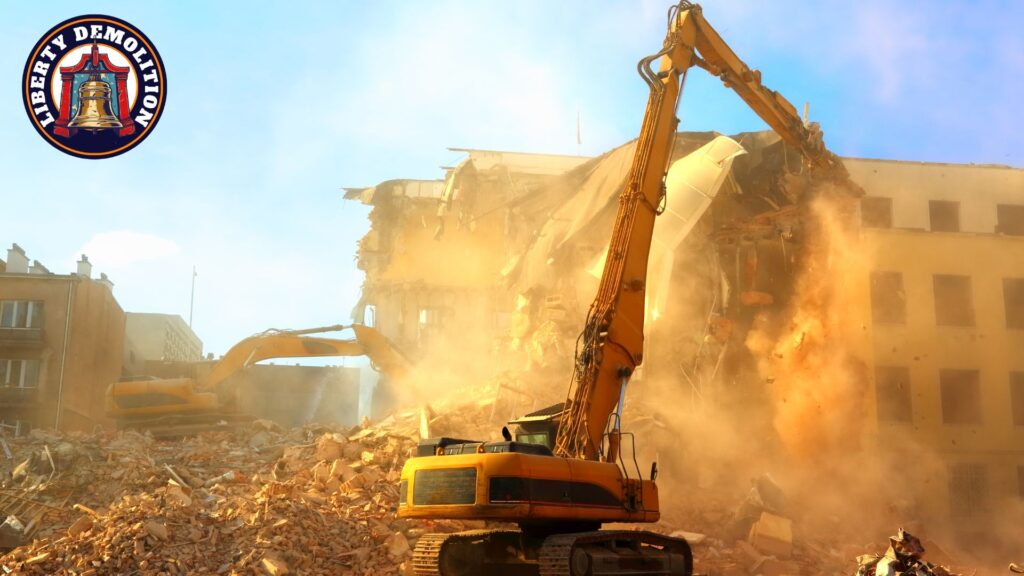
How Long Does Concrete Demolition Take?
When planning a concrete demolition project, one of the most common questions is, “How long will it take?” Several factors can influence the duration of a concrete demolition project:
1. Size and Complexity of the Structure
Naturally, the larger the structure, the longer it will take to demolish. But size isn’t the only determinant. A small but complex structure with intricate designs, reinforcements, or interconnected parts might take longer to demolish than a larger but simpler one.
2. Method of Demolition
Different methods come with different timelines:
- Mechanical Demolition: Using equipment like jackhammers or bulldozers can be fast but may be less precise.
- Explosive Demolition: While blowing up a structure is quick, the preparation and cleanup can extend the timeline.
- Chemical Methods: Expansive grouts can be slower as they require time for the chemical reactions to occur and crack the concrete.
- Robotic and Manual Demolition: These methods provide precision but can be more time-consuming.
3. Access to the Site
If the site is located in a densely populated urban area, restrictions on noise, vibrations, and working hours can extend the project’s duration. Similarly, if the site is challenging to access, it may take longer to transport equipment and materials, affecting the timeline.
4. Regulatory and Permitting Delays
Acquiring the necessary permits for demolition can be time-consuming, especially if environmental or historical considerations come into play. Delays in paperwork or inspections can push the start date and overall project timeline.
5. Weather and Environmental Factors
Weather conditions can significantly influence the pace of demolition. Similarly, environmental concerns, like nesting birds or protected species in the area, might require pauses.
6. Preparatory Work
Before the actual demolition begins, various preparatory tasks must be completed, such as utility disconnections, safety inspections, and site setup. This prep work can add to the project’s overall duration.
7. Cleanup and Debris Removal
Demolition doesn’t end with the structure’s collapse. Debris removal and site cleanup can be time-intensive, especially if recycling or careful disposal is required.

What’s the Cost Involved in Concrete Demolition?
A common concern for anyone considering a concrete demolition project is the potential cost. Like the timeline, costs can vary widely based on various factors:
1. Size and Type of Structure
The bigger and more complex the structure, the higher the cost. Larger structures require more manpower, equipment, and hours of labor. Similarly, structures with multiple levels, thick reinforcements, or specialty materials may entail higher costs.
2. Method of Demolition Selected
- Mechanical Demolition: Renting or operating heavy machinery like bulldozers or jackhammers involves significant costs.
- Explosive Demolition: While the explosion might be swift, costs can mount due to the expertise required, specialized equipment, and post-blast cleanup.
- Chemical Methods: The use of expansive grouts or other chemical agents adds to the cost, especially if large quantities are required.
- Robotic or Manual Demolition: While offering precision, these methods can be labor-intensive and may carry higher labor costs.
3. Location and Accessibility
Transporting machinery in and out, managing noise and disruption, and working within city-imposed guidelines can all add to expenses.
4. Permitting and Regulatory Fees
Securing necessary permits often comes with fees. Additionally, if special inspections or surveys (like environmental or historical assessments) are mandated, these can add to the overall cost.
5. Environmental Concerns
Specialized removal and disposal methods become necessary if there are hazardous materials, such as asbestos or lead. These procedures, crucial for safety and environmental protection, can be cost-intensive.
6. Debris Removal and Disposal
Transporting, recycling, or disposing of demolition waste involves costs. These costs can vary depending on the volume and type of waste and the distance to disposal or recycling centers.
7. Unforeseen Challenges
Demolition projects can sometimes uncover unexpected problems – like hidden structural issues, unknown utilities, or buried waste. Addressing these surprises can lead to increased costs.
8. Insurance and Liability Coverage
Ensuring safety and compliance during demolition requires insurance coverage. The nature and extent of the coverage will influence costs, with larger or riskier projects potentially demanding higher premiums.
Bringing It All Down: Why Wait? Act Now!
Concrete demolition is an challenging process affected by size, location, methodology, and environmental considerations. The timeline and costs associated with these projects can vary, depending on the need for expertise and meticulous planning.
At Liberty Demolition, we understand these complexities inside out. Offering many services ranging from Residential to Industrial demolition, our commitment remains consistent. We ensure safety, environmental responsibility, and complete customer satisfaction. Coupled with our diligent waste management and recycling efforts, we guarantee an eco-friendly, seamless solution for all your demolition needs.
If you’re looking for a trusted partner to guide and support you in your next demolition project, look no further. Let our experienced demolition contractors in Philadelphia handle it with safety and efficiency. Call us, and we’ll give you a free quote!
